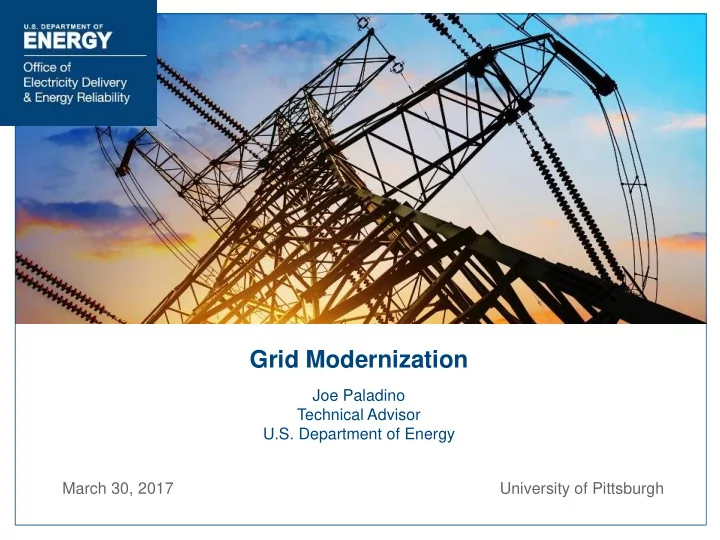

Grid Modernization Joe Paladino Technical Advisor U.S. Department of Energy March 30, 2017 University of Pittsburgh
Confluence of Factors Driving Grid Transformation Evolving Federal and State Policies • Renewable Portfolio Standards • Asset Utilization • Reliability and Resilience • Integration of Distributed Energy Resources Emerging Technology • Information and Communication New Market Entrants Technology (ICT) & • Generation and Management of • DERs: Electricity by Customers and 3 rd o Solar and Wind Parties o Energy Storage • DER Service Providers o Electric Vehicles o Microgrids o Building Systems 2
PV Adoption • Source: U.S. Department of Energy With reduced costs, adoption has increased • Convergence of attractive prices, commercial offerings and favorable state policies greatly enhances adoption (HI) • Energy storage undergoing similar trend; implications for DERs 2x in 3 years to 17% of All Customers Source: HECO cited in Hawaii PUC Order No. 34281 3
System Requires More Flexibility California “Duck” Curve DERs (and bulk-system factors) present considerable variability and uncertainty in both generation and load profiles challenging both planning and operations 4
DERs Provide Value From “Evolving Distribution Operational Markets” by Paul De Martini, Resnick Institute, Caltech, and Brenda Chew, Dale Murdock and Steve Fine at ICF 5
Attributes of a Future Grid • Integration of renewable and distributed resources (electric cars, smart buildings, PV, wind, energy storage, microgrids, community energy) • Shared ownership and responsibility of the electric grid planning and operations (T, D & C) • Multi-directional flow of energy, information and money • Evolved model for the utility business (platform provider) and regulation to ensure reliability, efficiency, affordability, security and innovation • Value creation through integrated networks and convergence (smart cities) 6
Co-Existing Futures Large IOUs, some PPAs and High end automation, high DER verticals penetration, etc. Technological Complexity Smart Cities Increasing local energy Localization determinism: DG, multi-user Today microgrids, CCA, etc.) Coops, rural utilities Less automation, some DER penetration Some PPAs and verticals 7
Considerations for Advancing Understanding Policy/Institutional Considerations: Integrated Determining Industry/Business Models Rate Regulatory Policy Planning Value and Market Design Design Models Objectives Highly Coupled Technological Considerations: Data/Info Security Network Sensing Communications Control Management (physical/cyber) Convergence 8
Emerging Grid Complexity The potential of high penetrations of mixed DERs presents an entirely new problem in control, coordination and value-determination within distribution systems Grid Decisions Building Decisions INFO ENERGY $ EV Decisions Storage Decisions Considerations: Extensibility: accommodating system growth and DERs • Scalability: aggregation of coordination signals • Optimization: local & system, centralized & distributed control • Convergence: grid/ICT/buildings/transportation • Markets/Innovation: open access networks, platforms • 9
Laminar Decomposition Frameworks To enable scalability and selfish optimization with system optimization From JD Taft, Architectural Basis for Highly Distributed Power Grids: Frameworks, Networks, and Grid Codes, PNNL-25480, June 2016 10
Coordination Domain Coordination domain may encompass, e.g., an entire distribution operator service territory, substation service territory, distribution feeder, microgrid Domain coordinator node is responsible for solving the local coordination problem and enabling self-optimization (to meet local objectives) From JD Taft, Architectural Basis for Highly Distributed Power Grids: Frameworks, Networks, and Grid Codes, PNNL-25480, June 2016 11
Convergence From “Value Creation Through Integrated Networks and Convergence”, De Martini and Taft, February 2015 12
References doe-dspx.org gridarchitecture.pnnl.gov Also: • Future Electric Utility Regulation Series at Lawrence Berkeley National Laboratory: website exists • Results of Smart Grid Projects Funded Under the Recovery Act: www.smartgrid.gov 13
Recommend
More recommend